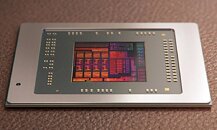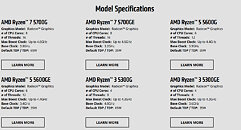Tuesday, April 13th 2021

AMD Launches Ryzen 5000G "Cezanne" APU Lineup for OEMs
AMD has today decided to launch the next generation of Accelerated Processing Units (APUs), now in form of the 5000G lineup codenamed Cezanne. The APUs are getting launched as OEM-exclusive products for now, which means that only manufacturers like Dell, HP, Lenovo, etc. can have access to them. AMD is set to announce these processors for wider masses, such as consumer DIYers, later this year. So you must be wondering what is new about the 5000G APUs. For starters, the new APUs feature AMD's improved Zen 3 core with a notable IPC boost over Zen 2 found in last generation 4000G APUs. When it comes to graphics, the new APUs feature anywhere from 6-8 GPU cores, based on the Vega architecture.
When it comes to the available models, AMD lists six SKUs, all differentiating in CPU/GPU core count, TDP, and frequency. There are three regular SKUs, with their power-efficient variants. The regular SKUs are AMD Ryzen 7 5700G, Ryzen 5 5600G, and Ryzen 3 5300G. They are normal SKUs that have a TDP of 65 Watts, meaning a higher base frequency needing a more adequate cooling solution. However, as there are regular SKUs, there are also power-efficient, TDP-constrained models present. Called the AMD Ryzen 7 5700GE, Ryzen 5 5600GE, and Ryzen 3 5300GE, these models bring the TDP down to 35 Watts and reduce base frequency by a couple of hundreds of MHz.The listed models, which you can see specifications of, are for now OEM-exclusive products. For general consumers, the announcement should follow sometimes in the coming months, so you have to wait to get these processors for a bit longer. For more information, please visit AMD's website and find greater details about them.
Source:
AMD
When it comes to the available models, AMD lists six SKUs, all differentiating in CPU/GPU core count, TDP, and frequency. There are three regular SKUs, with their power-efficient variants. The regular SKUs are AMD Ryzen 7 5700G, Ryzen 5 5600G, and Ryzen 3 5300G. They are normal SKUs that have a TDP of 65 Watts, meaning a higher base frequency needing a more adequate cooling solution. However, as there are regular SKUs, there are also power-efficient, TDP-constrained models present. Called the AMD Ryzen 7 5700GE, Ryzen 5 5600GE, and Ryzen 3 5300GE, these models bring the TDP down to 35 Watts and reduce base frequency by a couple of hundreds of MHz.The listed models, which you can see specifications of, are for now OEM-exclusive products. For general consumers, the announcement should follow sometimes in the coming months, so you have to wait to get these processors for a bit longer. For more information, please visit AMD's website and find greater details about them.


39 Comments on AMD Launches Ryzen 5000G "Cezanne" APU Lineup for OEMs
Who the hell is the painter Dragon Crest then?
What's after this... Smeagol? I'm lost
since they can’t fulfill the order on high volume ehm same node ehm, this most likely be ignored, no matter how fast they are, if they can’t fulfill forget being on Optiplex boxes on large quantities
8 RDNA2 CUs would be slightly faster than 8 Vega CUs overall, and would use less power, but would use significantly more die area, which would reduce availability and increase prices. We shouldn't want AMD to put RDNA2 on desktop APUs until it's worthwhile for them to do so (which even DDR5 might not be enough for, though it's hard to predict at this point).
It would be possible to make a larger iGPU if you included HBM with it (and AMD and Intel actually did this a few years ago when they collaborated to design "Hades Canyon"), but due to the high cost of HBM and the interposers it requires, it's more profitable for AMD to sell high-end GPUs and CPUs separately. The console SoCs can provide enough bandwidth for a powerful iGPU at relatively low cost because they use GDDR6, but not in a form factor that would be possible to fit into a socketable CPU.
Hypothetically we could see some sort of console-PC hybrid with a soldered high-end APU, or something similar to Intel's NUC modules that could be used in a small chassis, but it's unlikely that AMD would take a risk on a project like this any time soon, as they're still relatively small, and currently making a ton of profit by selling GPUs and CPUs separately.
So by walking into a shop and being recommended and AMD machine and it bring in stock and that consumer having a positive experience they'll remember that when buying their next machine, or getting a machine for their parents, kids, recommending to neighbours and friends etc.
If AMD capture the mindshare of the mainstream market then they have more money to pour into tmsc and produce chips for folks like us.
Lord forbid I lose a couple hundred rather than wait.
But no way I’d buy a tower with a motherboard using horizontally aligned DIMMs.
In 2022 ill have the next 9 weeks school then ill buy Alderlake, fck AMD